| Articles | https://doi.org/10.21041/ra.v13i3.660 |
Analysis of the mechanical properties of an expansive soil for the self-construction of a social housing
Análisis de las propiedades mecánicas de un suelo expansivo para la autoconstrucción de una vivienda de interés social Análise das propriedades mecânicas de um solo expansivo com vistas à autoconstrução de uma habitação social
1 Secretaría Académica, Facultad de Ingeniería, Universidad Autónoma de Querétaro, Santiago de Querétaro, México.
2 Estudiante de la Maestría en Ciencias línea terminal en Geotecnia, Facultad de Ingeniería, Universidad Autónoma de Querétaro, Santiago de Querétaro, México.
*Contact author: mgonzalez305@alumnos.uaq.mx
Reception: January 26, 2023.
Acceptance: August 31, 2023.
Publication: September 01, 2023.
| Cite as: González, M., Pérez, M. (2023),“Analysis of the mechanical properties of an expansive soil for the self-construction of a social housing”, Revista ALCONPAT, 13 (2), pp. 312 –327, DOI: https://doi.org/10.21041/ra.v13i3.660 |
Abstract
This research article shows an analysis of an expansive soil of the Residencial Santa Fe, in the eastern part of the city of Santiago de Querétaro, Mexico, in order to determine the annual period in which it is more convenient to start the self-construction of a social housing. The mechanical properties of the soil (expansion pressure, friction angle and cohesion) are determined by geotechnical tests to find out the possible differential movements of the ground and thus avoid the short-term deficiencies that these houses suffer in our country, obtaining that the ideal period for the construction is October-March, otherwise, in the April-September period it is critical, for which the foundations increase in cost.
Keywords:
self-construction,
expansion pressure,
friction angle,
cohesion.
1. Introduction
In the teaching of soil mechanics and geotechnical engineering, soil is considered dry or saturated. It is also believed that soil behavior is only controlled by Terzaghi's principle of effective stress. In fact, the dry state and the saturated state are only soil boundary conditions (Flores et. al., 2019).
Figure 1 shows how the water table is the boundary between saturated and unsaturated soil. Under this level, the effective stress (σ-uw) is what governs the behavior of the soil; while, above the water table, there are two independent variables to consider: the total effort(σ-ua) and the matric suction (ua -uw).
Where:
σ = normal stress
ua = air pore pressure
uw = wáter pore pressure
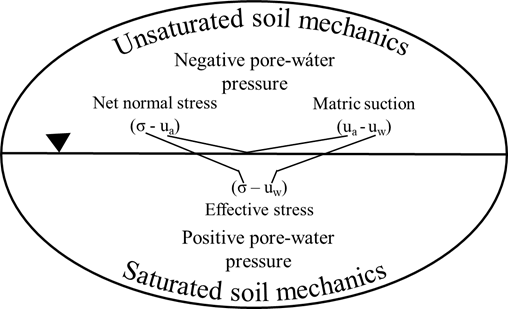 |
||||
| Figure 1. Overview of soil mechanics (Guerrero, 2013). | ||||
Vertisol soils have the characteristic of retaining a large amount of water, added to this, their cation exchange capacity makes them possess a high natural fertility; in Mexico and the world they are considered one of the most productive materials for agriculture (Torres et. al., 2016).
Usually, its clay content is uniform and greater than 35%, although in many cases it exceeds 80%. Among its characteristics are the presence of cracks, a dark color with a fine uniform texture and a low content of organic matter; although its most important property from the point of view of soil mechanics is expansiveness due to the presence of montmorillonite, which causes expansions or contractions due to the hydration or dryness of its particles, volume changes range from 35 to 50%. This occurs mainly in arid and semi-arid areas (Torres et. al., 2016).
In the Mexican Republic, it has been found that about 25% of the territory has vertisol on its surface as the main soil or as associated soil. Second or third, however, it is considered that only half of this percentage corresponds to environmental conditions that favor the expansive behavior that causes so much damage in construction. Figure 2 shows the regions of the Mexican territory where vertisol soils abound with the mineral montmorillonite as their main constituent.
 |
||||
| Figure 2. Potential areas of expansive soils in the Mexican Republic (Zepeda and Castañeda, 1989). | ||||
The city of Querétaro consists of four important geotechnical zones, as shown in Figure 3, which are: rocky, hillside, haulage and valley; the latter being the plain of the city and is where most of the expansive clays were deposited (Álvarez et. al., 2017).
Added to this, the metropolis is in a semi-arid area with a water table below eight meters deep, this means that the decrease in the water content on the surface due to evaporation, added to the loss of moisture due to transpiration (evapotranspiration) is greater than the wetting of this same surface (precipitation) in an annual period of time and that in turn suction must be taken into account because in small and light constructions, the forces exerted by the structures remain within the unsaturated area, which with considerable changes in its water content can affect the constructions (López, 2014).
Total suction refers to the energy associated with the soil's ability to retain water (Carrasco, 2017). Ridley (1993) defined it as the energy required to remove water molecules from the soil matrix by evaporation. The energy needed to extract water from the soil, or total suction, has two components, one due to capillary action, called matrix suction, and another due to the salts dissolved in the water, called osmotic suction. The main geotechnical problems associated with unsaturated soils are related to environmental changes that mainly alter matrix suction and, to a lesser extent, osmotic suction (Carrasco, 2017).
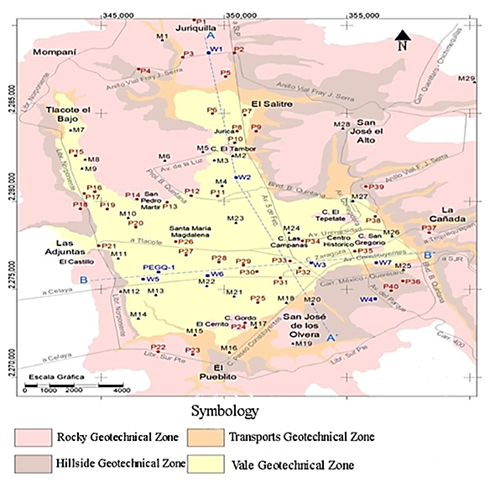 |
||||
| Figure 3. Geotechnical zones in the city of Querétaro (Álvarez et. al., 2017). | ||||
On the other hand, in Mexico, social interest housing has increased its demand, this due to several factors such as: medium-accessible costs, comfort (long-term payments) and its easy availability. The problem with this situation is that no matter where in the country they are built, the construction process is the same, without previously analyzing the characteristics of the subsoil where they are located, adding that the future settlers of the buildings are not given plans or previous studies that endorse the correct construction. When this occurs on expansive soil and in regions where the climate is semi-arid, where the rainy and dry seasons are clear, the terrain undergoes significant volume changes due to the water content present in its structure, this produces that single-family houses tend to present deficiencies in the short term, such as: elevation or subsidence of pavements and cracks in walls and frames.
Previously the population could only be creditors of a new or used house with a mortgage loan, but at present there is a reform in which they can build their own social interest housing without intermediaries, where what is required is the following:
- Characteristics of the land: have public deeds registered in the public service, that the property is in your name or that of your spouse, have essential services, be located in a risk-free area in accordance with local regulations and have the use of residential land.
- Construction planning: the construction must have at least a bedroom, living room, kitchen and bathroom; include ecotechnologies and must be executed by a registered technician (architect, engineer, master builder) before the social service body that comes.
- Additional expenses: preparation of the executive project, construction license, appraisal and technical opinion.
With this, this paper aims to present a simple way to help citizens make the best decision to start the self-construction of their home, finding out which month of the year is the most viable due to the possible volumetric changes that the ground where their house is located may have.
2. Procedure
2.1 Experimental methodologies
The methodology implemented was the traditional one that is executed in a geotechnical report: determine the location of the works and the type of exploration carried out, laboratory tests, results and conclusions.
2.1.1 Research area
The area studied was the eastern part of the City of Querétaro, specifically the Santa Fe Residential, verifying that it is part of the valley of the Querétaro territory and from where a black clay was obtained at a depth of 1.5 meters.
Figure 4 shows exactly where the samples were collected, where altered and unaltered material was obtained through an open pit exploration (PCA).
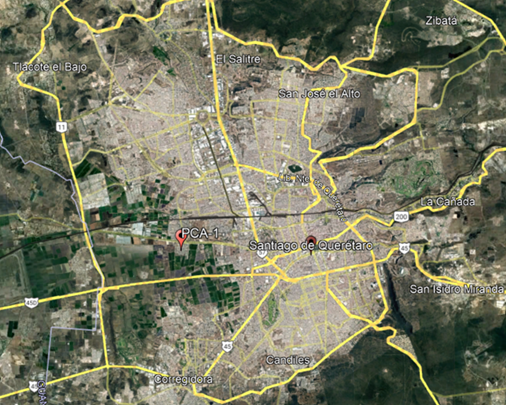 |
||||
| Figure 4. Sketch of the location of the survey within the City of Querétaro. | ||||
PCA-1 2277086.00 m N, 349166.00 m E
2.1.2 Laboratory tests
Soil mechanics laboratory tests are tests performed to determine the mechanical properties of soil as part of soil identification methods. Soils can be characterized and classified by the procedures they undergo in laboratory tests.
2.1.3 Annual precipitation
The National Water Commission (CONAGUA) annually issues real data on precipitation by Federal and National Entity. For this research work, the data provided for the state of Querétaro are shown in Table 1. The values reported by CONAGUA, compared with data from different previous research works carried out in the Santa Fe subdivision of the city of Querétaro, may support, taking into account another aspect such as volumetric change, conclusions that allow determining which period is the most appropriate to carry out self-construction.
| Table 1. Average annual rainfall data (mm) for the Entity of Querétaro (Conagua, 2022). | ||||||||||||||
| Precipitation (mm) by Federal and Nacional Entity 2022 | ||||||||||||||
|---|---|---|---|---|---|---|---|---|---|---|---|---|---|---|
| Entity | Jan | Feb | Mar | Apr | May | Jun | Jul | Aug | Sep | Oct | Nov | Dec | Annual | |
| Querétaro | 3.8 | 5.8 | 0.7 | 19.1 | 4.7 | 47.8 | 57.1 | 67.1 | 98.3 | 40.3 | 22.4 | 7.7 | 374.6 | |
2.2 Experimental techniques
Experimental techniques refer, for the purposes of this work, to all laboratory tests carried out to obtain the results. Each of these has its most current regulations for reliability in the analysis of the data obtained.
2.2.1 Characterization of expansive soil
The plasticity index, the specific surface and the activity are some parameters that help to know if a soil is potentially expansive; for this, the Atterberg limit tests with the ASTM D 4318-2010 standard, the methylene blue test with the C837-2019 standard and the hydrometer granulometry with the ASTM D422-2007 standard, will be necessary to obtain the values of each concept respectively. According to Nelson et. al. (2015), the values shown in Table 2 are ranges that can be used for the consideration that the material will present considerable volumetric variations.
| Table 2. Properties of potentially expansive soil. | ||||||||||||||
| Plasticity index (%) | 20-55 | |||||||||||||
| Specific Surface area (m2/g) | 600-800 | |||||||||||||
| Activity | >1.5 | |||||||||||||
2.2.2 Soil suction characteristic curve
The relationship between soil water content and suction is determined by the soil water characteristic curve (SWCC). This relationship is also known in soil science as the water retention curve. SWCC's concept and interpretation are critical to understanding the mechanics of partially saturated soils. Therefore, few studies have focused on finding the relationship between soil SWCC and its physical and mechanical properties (Casanova, 2018; Yáñez et al., 2015).
The test to determine the suction potential is in ASTM D 5298-2010, which consists of obtaining ten unaltered samples of approximately five cubic centimeters, which will be brought to different water contents. Moisture from the soil sample will rise towards the filter papers in contact with it. The paper will be calibrated to establish a relationship between its moisture and the level of suction in the soil pores.
The filter paper used is calibrated with different solutions of distilled water and sodium chloride to evaluate the relative humidity of the water.
Once the paper has been calibrated, the samples are placed in different containers with two filter papers on top, above these an airtight material is placed followed by another paper, once this is done, the bottle is closed and left to rest for seven days.
After seven days, the papers that are in contact with the material will be weighed, a process that should not take longer than 4 seconds to prevent the papers from losing moisture.
The upper filter paper represents the matric suction while the lower one the osmotic, added together the two, the total suction is obtained, which is obtained by means of the weights of the papers and the calibration of this.
Each floor has a different SWCC. In addition, soils have "hysteresis" which is due to the fact that the hydration and drying processes depend on the shape of the pores. This results in the shape and position of the drying and wetting paths not being the same.
Figure 5 shows the parts of the SWCC.
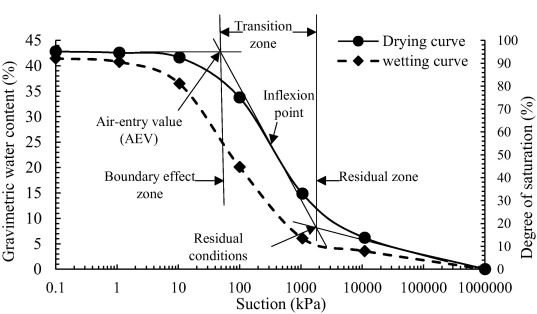 |
||||
| Figure 5. Typical characteristic curve of a soil (Musso and Suazo, 2019). | ||||
2.2.3 Mechanical properties of a soil
The most important mechanical properties of a soil are those that allow us to establish laws of resistance and behavior, such as cohesion, the angle of internal friction and its expansive capacity.
- Cohesion: bonding between soil particles due to the attractive force of molecules.
- Internal friction angle: parameter necessary to obtain the resistance to shear stress of a soil.
- Expansion: change in soil volume due to a load and saturation.
To determine these soil properties, the triaxial CD (consolidated drained) test is ideal for obtaining reliable results because it allows the drainage to be free during the test time, allowing the sample to consolidate due to the different states of load applied to it, thus ensuring that the effective stresses are those that are being developed in the tested soil sample.
For this test, the procedure to be used is that described in ASTM D 7181-20, which mentions that they must be unaltered specimens, which must be placed in the triaxial chamber and previously consolidated before applying the load. The typical result of a triaxial CD test is shown in Figure 7.
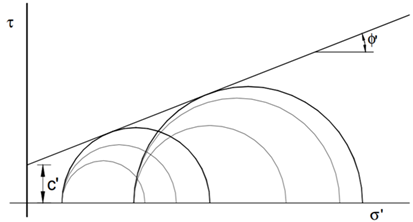 |
||||
| Figure 7. Result of a triaxial CD test (consolidated drained). | ||||
In addition, the expansion test is based on ASTM D 4546-2008 method B, which consists of placing an unaltered sample inside a consolidation ring in an odometer. An initial load is applied that is equal to the one in place and is saturated to allow the soil to expand. The test consists of loading several load intervals until the straight stretch of the compressibility curve is defined and then unloading the specimen in the same way in a period of 72 hours so that the swelling of the sample can finally be observed to obtain the change in volume, as well as the value of the expansion pressure.
3. Results
The soil studied showed characterization tests; a liquid limit of 73.0%, plastic limit of 32.4%, so the plastic index is 40.6%; a specific surface area of 784.69m2/g and an activity of 1.5. The presence of an expansive soil can be assumed, in addition, due to its Atterberg limits, the description of the material is a clay of high compressibility (CH) in the plasticity chart.
For the results of the suction of the soil, Figures 8 and 9 show the values of total suction and matric suction respectively where it can be seen that, the higher the value in the suction, the lower the moisture content in the specimen and vice versa; the higher the humidity, the lower the suction.
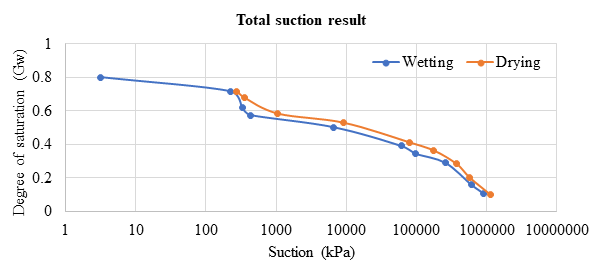 |
||||
| Figure 8. Total suction of the soil studied. | ||||
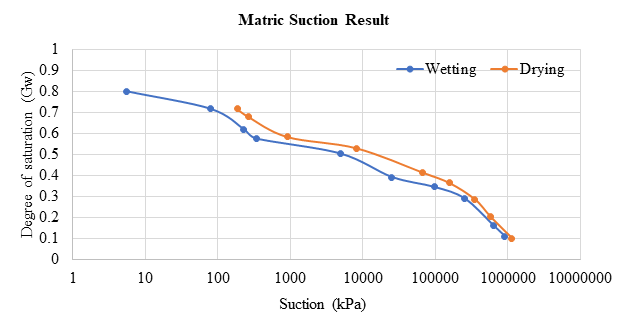 |
||||
| Figure 9. Matric suction of the soil studied. | ||||
The soil analyzed, with a volumetric weight of 1.69 g/cm3, a relative density of 2.75 and a natural humidity of 28%, results in a degree of saturation of 70%; which is reflected as a matric suction of 200 kPa and a total suction of 400 kPa.
In the triaxial CD tests, three series were performed with different humidity, each series consists of three specimens to which different confinement pressure values were applied.
The value of the confinement pressure is due to the coefficient of ground pressure at rest "in situ" developed by Massarsch (1979).

where Ip refers to the plasticity index, with the value that it has, the coefficient gives a value of 0.44, so a value of k0 = 0.5will be used, according to Massarsch.
The vertical stress is determined by the specific weight of the soil (1.69 g/cm3) and the depth at which the sample was obtained (1.6m).
The horizontal stress, which is the confinement stress is obtained by the vertical stress by the coefficient of pressure at rest.
Once this value is obtained, a lower value and a higher value are obtained to have three different confinement stresses (0.68 g/cm2, 1.35 g/cm2 and 2.7 g/cm2) and to be able to obtain the friction and cohesion angle values in the soil using a Mohr graph.
The results of the triaxial tests are shown below in Figures 10, 11 and 12.
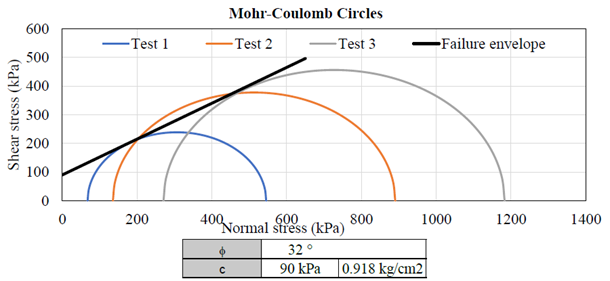 |
||||
| Figure 10. Friction and cohesion angle values with 13% humidity. | ||||
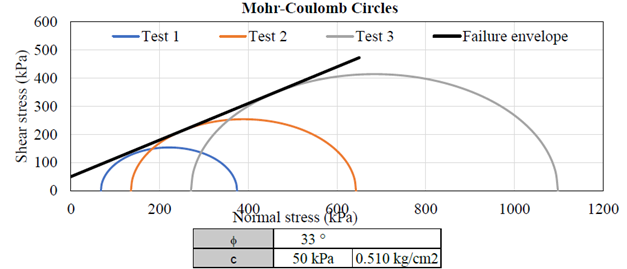 |
||||
| Figure 11. Friction and cohesion angle values with 28% humidity. | ||||
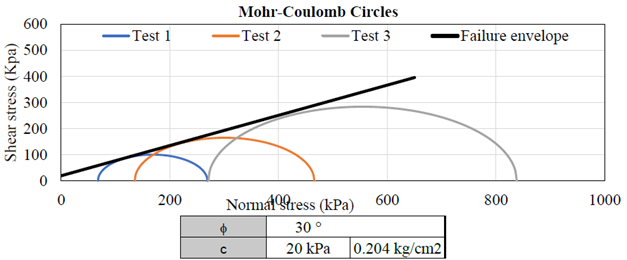 |
||||
| Figure 12. Friction and cohesion angle values with 43% humidity. | ||||
The results of the expansion tests are shown below in Figures 13, 14 and 15; which were obtained by a technique called triple odometer, a procedure that covers the ASTM D4546-2008 standard.
 |
||||
| Figure 13. Soil expansion pressure with 13% humidity. | ||||
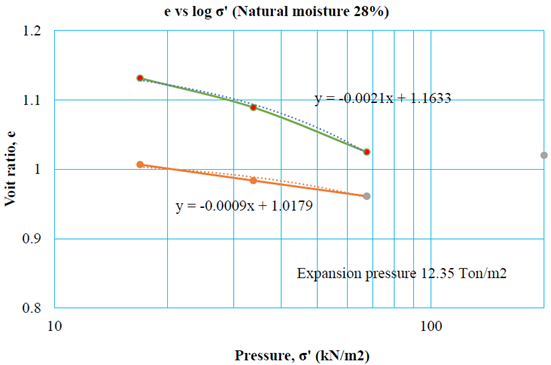 |
||||
| Figure 14. Soil expansion pressure with 28% humidity. | ||||
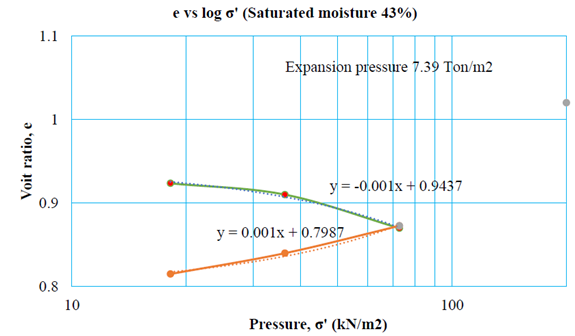 |
||||
| Figure 15. Soil expansion pressure with 38% humidity. | ||||
Finally, to determine which period is recommended for initial self-construction, the work of Lezama, J. M. (2017), Antonio, Y. (2014), Montes, E. (2018) and the samples carried out for this work were taken into account to prepare the graph presented in Figure 16 that shows the natural water contents and the expected volumetric changes in a calendar year in order to compare them with the precipitation data of CONAGUA. To have the percentages of precipitation, the month of September is considered as 100%.
It is worth mentioning that the water content data obtained by the different authors were considered in the characteristic curve of Figure 9 to determine the suction of the materials and obtain their volumetric change. Values such as the specific weight of the material and the relative density are necessary, in addition to what is mentioned in this paragraph, to know the degree of saturation of the soil.
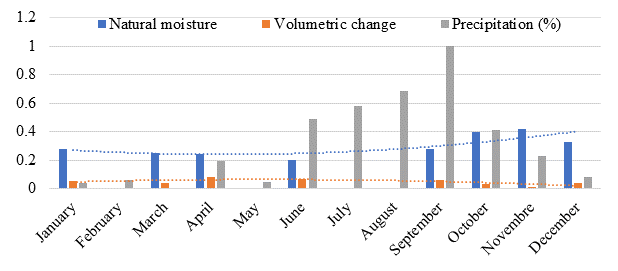 |
||||
| Figure 16. Moisture contents and volumetric change in Santa Fe clay in an annual period. | ||||
4. Discussion
In Mexico, the vast majority of expansive soils are found in the unsaturated part of the subsoil, this means that the water content in their structures tends to be very volatile depending on the climatic changes that occur in the earth's crust; this means that these materials tend to undergo considerable volumetric changes.
For the issue of the construction of housing of social interest, what is mentioned in the previous paragraph is very important to take into account because the expansion pressures that the soil may suffer are greater than the weight that it will transmit from the property to the subsoil, considering that a single-family house is a very light structure that can easily allow problems such as lifting or sinking of pavements and cracking of walls.
From the results of the laboratory tests carried out, it is observed that the friction angle is a negligible parameter because there is no change in its value when soil saturation conditions vary, so cohesion is the value that will determine the behavior of the material
On the other hand, the expansion pressure is lower when the land has a high water content than, considering Figure 16 where the volumetric change will be equally lower, so these two terms are related to each other.
Due to these data and those in Table 1, it is determined that some months of the year are more susceptible to the beginning of the self-construction of a home, this due to the water content that the expansive soils may have at the beginning of the works. This period of time would be approximately one month after the end of the rainy season, so that the soil is not completely saturated and has a low expansion potential.
Another case would be the month of May, which is the driest month in the Bajío region (Querétaro), where it is not advisable to start self-construction in this period because the soil will be in the process of drying out and in subsequent months where the rains begin to fall, it will produce a considerable volume change that could damage the foundation.
There is a method that is the pre-saturation of the soil, it is a technique used to bring the material to its wet state and thus no longer have problems with volume changes or expansion, but remembering that clays are impermeable materials, and due to their high capacity to absorb water, the amount of water that must be used to pre-saturate the soil is too much; when in this technique only a few pipes are used for its implementation.
5. Conclusions
Based on rainfall results obtained from CONAGUA, the recommended annual period for the self-construction of housing of social interest is October-March, a period in which the average fall of water absorbed by the land is decreasing, while the most critical period to work is April-August due to the potential for volume change in the soil.
If it is desired to build in the critical period, volumetric changes and soil expansion pressure must be taken into account, so in the design of a foundation it must be rigid enough to withstand these efforts; this leads to a higher cost in the concept of the foundation of the house.
The soil never becomes totally dry due to the concept of suction and at the same time, not totally humid, excessive rainfall is needed to reach saturation, which is not recommended to start a self-construction due to the sliding of walls in excavations.
In the Mexican Republic there are several areas where expansive soils are present, so the average annual rainfall of each region must be analyzed to know with certainty what is the recommended period where the house will be self-constructed.
From the mechanical properties of an expansive clay, it is observed that cohesion changes depending on the water content, this is directly related to the suction of the same soil: at a low moisture content, cohesion and suction are high; conversely, if the water inside the structure is high, the properties of the material are low.
The soil studied has a medium-high degree of saturation, so suction and cohesion can be altered in times of drought with a large change in suction and potential for volumetric change, while in the rainy season (June-September) the reduction in suction is little but the material loses resistance as its cohesion decreases.
6. Acknowledgements
The authors express their gratitude to the Faculty of Engineering Universidad Autónoma de Querétaro for the support and facilities provided, such as the use of the Geotechnical Laboratory to carry out the tests that set the tone for the preparation of this research work.The National Council of Science and Technology (CONACYT) is thanked for the financial support granted.
References
Álvarez, A. et al. (2017), Contribución de las Frecuencias Características al Periodo de Vibración Dominante en la Ciudad de Querétaro, México. Revista de Ingeniería Sísmica No. 97: 84-101. https://doi.org/10.18867/ris.97.482.
Antonio, Y. (2014). “Evaluación del impacto de la contaminación con diésel en las propiedades mecánicas de un suelo arcilloso”, Tesis de Maestría en Ciencias, Universidad Autónoma de Querétaro, p. 57 - 69. https://ri-ng.uaq.mx/handle/123456789/333
ASTM International. (2020). ASTM D7181-20 a Standard Test Method for Consolidated Drained Triaxial Compression Test for Soils. DOI: https://doi.org/10.1520/D7181-20
ASTM International (2010). ASTM D5298-10 a Standard Test Method for Measurement of Soil Potential (Suction) Using Filter Paper. DOI: https://doi.org/10.1520/D5298-10
ASTM International (2019). ASTM D837-19 a Standard Test Method for Methylene Blue Index of Clay. DOI: https://doi.org/10.1520/C0837-09R19
ASTM International (2007). ASTM D422-07 a Standard Test Method for Particle-Size Analysis of Soils. DOI: https://doi.org/10.1520/D0422-63R07
ASTM International (2010). ASTM D4318-10 a Standard Test Methods for Liquid Limit, Plastic Limit, and Plasticity Index of Soils. DOI: https://doi.org/10.1520/D4318-10
ASTM International (2008). ASTM D4546-08 a Standard Test Methods for One-Dimensional Swell or Collapse of Cohesive Soils. DOI: https://doi.org/10.1520/D4546-08
Carraco J. C. (2017). “Implementación de Ensayos de Succión en Suelos Parcialmente Saturados y Análisis de Resultados en Suelos Residuales”. Tesis de Ingeniería Civil. Universidad de Chile, p. 7-9.
Casanova, M. (2018). “Modelación elastoplástica de la curva de retención de agua en suelos parcialmente saturados”. Tesis de maestría. Universidad Politécnica de Catalunya. Barcelona, España. p. 15.
Conagua (2022). “Precipitación por Entidad Federativa y Nacional”. Comisión Nacional del Agua. https://smn.conagua.gob.mx/tools/DATA/Climatolog%C3%ADa/Pron%C3%B3stico%20clim%C3%A1tico/Temperatura%20y%20Lluvia/PREC/2022.pdf. 05/01/2023.
Flores, I. et. al. (2019), Estabilidad de taludes durante un desembalse rápido en presas de tierra con suelos parcialmente saturados”. Ingeniería y Desarrollo, p.15. https://doi.org/10.14482/inde.38.1.624.15.
Guerrero, C. (2013). “Interacción Suelo-Estructura en Arcillas Expansivas”. Tesis de Maestría. Universidad Nacional Autónoma de México, p. 11-15.
López T. et. al. (2014), Análisis de estructuras huecas invertidas colocadas sobre suelos expansivos. Sociedad Mexicana de Ingeniería Geotécnica: 1-2. http://www.smig.org.mx/admArticulos/eventos/19_XXVII_Reunion_Nacional_de_Ingenieria_Geotecnica/36_Reunion_Nacional/83_SUELOS_NO_SATURADOS/A10LOLT_1.docx
Lezama, J. M. (2017). “Estudio del índice de reactividad en suelos expansivos bajo diferentes condiciones de esfuerzo aplicado y humedad inicial”, Tesis de Maestría en Ciencias, Universidad Autónoma de Querétaro, p. 32-38.
Massarsch, K.R. (1979). “Lateral Earth Pressure in Normally Consolidated Clay”. 7th European Conference on Soil Mechanics and Foundation Engineering, Brighton, Proceedings, Vol. 2, pp. 245-249.
Montes, E. (2018). “Estabilización de suelos y eliminación de fenol mediante subproductos de la industria avícola”, Tesis de Doctorado, Universidad Autónoma de Estado de México, p. 47, 79-80.
Musso, J. y Suazo, G. (2019) “Determinación de la curva de retención de agua para relaves multimetálicos de la industria minera de Chile y Proyectos 25”, p. 22-29. http://dx.doi.org/10.4067/S0718-28132019000100022.
Nelson J. D. et. al. (2015). “Foundation Engineering for Expansive Soils”. John Wiley & Sons, Inc. New Jersey, United States of America, p. 30-38.
Torres, C. A. et al (2016). “Manejo agronómico de los Vertisoles en México: una revisión”. Terra Latinoamericana, 34(4), 457-466. Recuperado en 10 de abril de 2023, de http://www.scielo.org.mx/scielo.php?script=sci_arttext&pid=S018757792016000400457&lng=es&tlng=es. ISSN 2395-8030.
Yáñez, N., D. Dec, J. Clunes y J. Dörner. (2015). “Estimación de la curva de retención de agua de un Andisol bajo un cultivo de arándano, a través de funciones de pedotransferencia”. Agro Sur 43 (3): 63-72. DOI: https://doi.org/10.4206/agrosur.2015.v43n3-07
Zepeda, J. A. y Castañeda, A. H. (1989). “Distribución de suelos expansivos en la República Mexicana”. Curso Internacional de mecánica de Suelos Arcillosos. J. Alfredo Zepeda Garrido. México.
